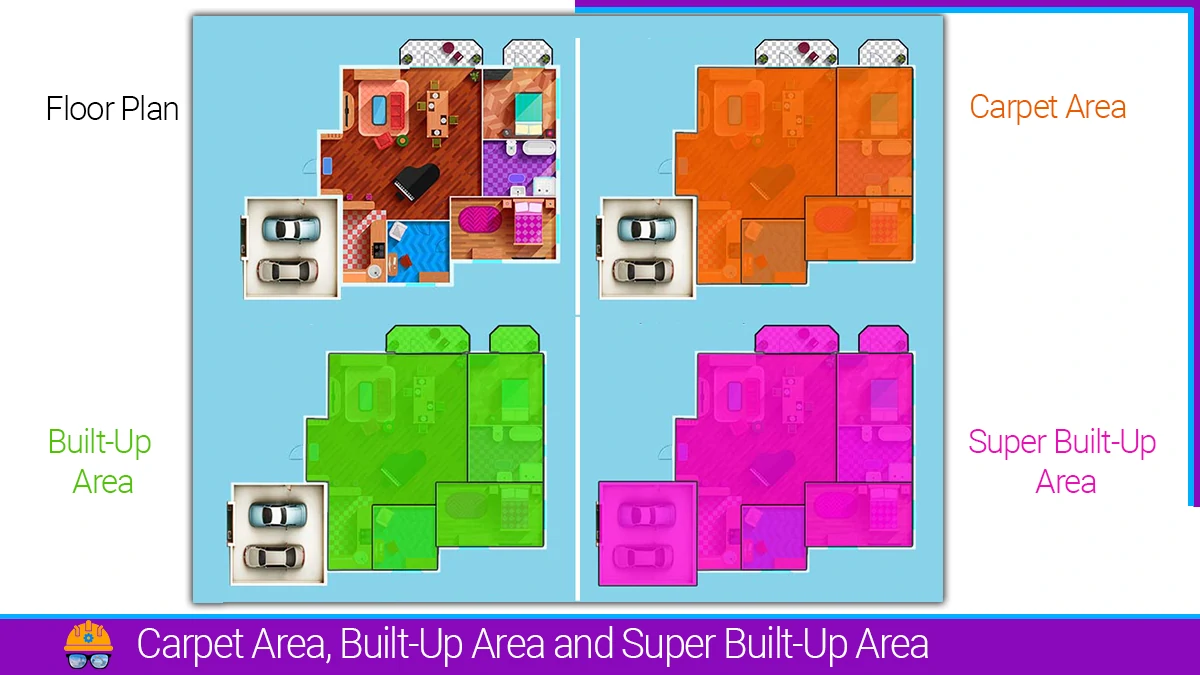Earthwork for road construction refers to the process of excavating, moving, and compacting soil and other materials to create the desired road profile. This is a crucial phase in road construction and involves various activities to prepare the foundation and subgrade for the road surface.
Lead and Lift:
Lead:
It is the average horizontal distance between the centre of excavation to the centre of deposition. The unit of lead is 50 m.
Lift :
It is the average height through which the earth has to be lifted from the source to the place of spreading or heaping. The unit of lift is 2.00 m for the first lift and one extra lift for every 1.0 m. For example, when the earth is to be lifted for 4.5m, four lifts are to be paid to the contractor. That is:-
| Upto 2.0 | 1 lift | 4 lifts Total |
| Upto 1.0 | 1 lift | |
| Upto 1.0 | 1 lift | |
| Upto 0.5 | 1 lift |
The cross-section of earthwork for roads in embankments or cuttings typically takes the shape of a trapezium. The volume of earthwork can be determined using the following calculation methods:
Quantity or Volume = Sectional Area X length
The terms “quantity” and “volume” for earthwork are often used interchangeably in this discussion.
Calculation of Earthwork for Road Construction
When the ground is in a longitudinal slope or the formation level has a uniform gradient throughout its length, the quantity of earthwork may be calculated by the various methods of mensuration out of which three methods are given below.
- Mid Section Method
- Trapezoidal Formula Method or Mean-Section Area Method
- Prismoidal Formula Method
Method 1: Mid-Section Area Method
The Mid-Section Area Method, also known as the cross-section area method is a technique to calculate the volume of earthwork or excavation required for a construction project by calculating first the average depth of two consecutive sections. From the mean depth, the area of the mid-section is to be worked out and the volume of earthwork is to be computed by multiplying the area of the mid-section by the length between the two original sections. This method is commonly employed when the shape of the ground is not uniform, and the cross-sections at the beginning and end of the area to be excavated or filled are different.
Volume = Area of Mid-Section X Length
Area of Mid-Section = Area of rectangular portion + area of two triangular portion
The earthwork quantities can be computed and presented in a tabular format as follows:
| Stations or Change | Depth or Height | Mean Depth or Height “dm” | Area of central portion “Bdm” | Area of Sides”Sd2“ | Total Sectional Area Bd+Sd2 | Length between section L | Quantity (Bd+Sd2 ) X L | |
|---|---|---|---|---|---|---|---|---|
| Embankment | Cutting | |||||||
Example: Estimate the quantity of earthwork for an embankment, 120 m long and 8 m wide at the crest and whose side slopes are 2 in 1. The central height at every 30 m intervals are 0.60 m, 1.10 m 1.60 m and 1.30 m.
| Stations or Change | Depth or Height | Mean Depth or Height “dm” | Area of central portion “Bdm” | Area of Sides”Sd2“ | Total Sectional Area Bd+Sd2 | Length between section L | Quantity (Bd+Sd2 ) X L | |
|---|---|---|---|---|---|---|---|---|
| Embankment | Cutting | |||||||
| 0 | 0.60 | |||||||
| 1 | 1.20 | 0.90 | 7.20 | 1.62 | 8.82 | 30.00 | 264.60 | |
| 2 | 1.60 | 1.40 | 11.20 | 3.92 | 15.12 | 30.00 | 453.60 | |
| 3 | 2.00 | 1.80 | 14.40 | 6.48 | 20.88 | 30.00 | 626.40 | |
| 4 | 1.30 | 1.65 | 13.20 | 5.45 | 18.65 | 30.00 | 559.50 | |
Therefore, the total volume of the earthwork is 1904.10 cum.
Also, read: Understanding Cubic Feet: Definition, Comparative Analysis, Importance, and Practical Examples
Method 2: Trapezoidal Formula Method or Mean-Section Area Method
This method is based on the assumption that the mid-section area of a pyramid is half the average section area of the ends and the end sections are in parallel planes.
The mean-section area method is a method for calculating the volume of earthwork involved in cutting or filling a piece of land. It is a simplified version of the prismoidal formula, and it is often used for preliminary calculations or for projects where the ground is relatively flat.
Volume = Mean Section Area X Length
The mean sectional area, \( A=\frac{A_1+A_2}2 \)
Volume, \( V=\frac{A_1+A_2}2\times L \)
The mid-section area of a prismoid equals half the average area of its ends. However, it’s crucial to note that the prismoid consists solely of prisms and wedges, excluding pyramids. Consequently, the calculated volume of the prismoid tends to be an overestimate. Despite this, for practical applications, especially when representing the Earth’s solid structure as a prismoid, this method proves sufficiently accurate.
To enhance precision, a prismoidal correction is implemented. This correction equals the difference between the calculated volume and the volume obtainable through the prismoidal formula.
The earthwork quantities can be computed and presented in a tabular format as follows:
| Stations or Change | Depth or Height “d” | Area of central portion “Bd” | Area of Sides”Sd2“ | Total Sectional Area Bd+Sd2 | Mean Sectional Area | Length between section L | Quantity (Bd+Sd2 ) X L | |
|---|---|---|---|---|---|---|---|---|
| Embankment | Cutting | |||||||
Method 3: Prismoidal Formula Method
The Prismoidal Formula Method is a mathematical approach to calculate the volume of earthwork, whether it involves excavation or filling. This method is particularly useful when the cross-sections at the beginning and end of a project differ significantly or when there is an irregular shape of the cut or fill.
The formula takes into account three areas: the cross-sectional area at the beginning of the section (\( A_1 \)), the cross-sectional area at the end of the section (\( A_2 \)), and the average cross-sectional area between these two points (\( 4A_m \)). The prismoidal formula is expressed as:
Volume, \( V=\frac6L\times\left(A_1+4A_m+A_2\right) \)
Cross-sectional area at one end
\( A_1=Bd_1+Sd_1^2 \)
Cross-sectional area at other end
\( A_2=Bd_2+Sd_2^2 \)
Cross-sectional area at middle
\( A_m=Bd_m+Sd_m^2 \)
\( d_m=\frac{d_1+d_2}2 \)
in the above equation
\( A_m=B\left(\frac{d_1+d_2}2\right)+S\left(\frac{d_1+d_2}2\right)^2 \)
The quantity or volume of cut or fill is given after substituting the equation,
Volume, \( V=\left[B\left(\frac{d_1+d_2}2\right)+S\left(\frac{d_1^2+d_2^2+2d_1d_2}3\right)\right]\times L \)
Volume = [Section Area of central portion + Section Area of side slope portions] X length
Trapezoidal Formula and Prismoidal Formula
Trapezoidal Formula and Prismoidal Formula Methods are employed for a series of cross-sections.
When a series of cross-section areas are calculated at equidistant points, the volume may be worked out by the Trapezoidal formula
Volume by Trapezoidal Formula Method:
\( V=\frac D2\left(A_0+2A_1+2A_2+2A_3…+2A_{n-1}+A_n\right) \)
Volume by Prismoidal Formula:
\( V=\frac D3\left(A_0+4A_1+2A_2+4A_3+2A_2+…2A_{n-1}+4A_{n-1}+A_n\right) \)
\( V=\frac D3\left(First\;Area+Last\;Area+4{\textstyle\sum_{}}Odd\;Areas+2{\textstyle\sum_{}}Even\;Areas\right) \)
Also, read: Types Of Estimates in Construction Projects
Prismoidal Formula method:
\( V=\frac L3\left(First\;Area+Last\;Area+4{\textstyle\sum_{}}Odd\;Areas+2{\textstyle\sum_{}}Even\;Areas\right) \)
\( V=\frac {20}3\left(First\;Area+Last\;Area+4{\textstyle\sum_{}}Odd\;Areas+2{\textstyle\sum_{}}Even\;Areas\right) \)
Also, read: Measurement of Earth Excavation and Estimation
FAQs:
Q: How is earthwork volume calculated for road construction?
Ans: Earthwork volume is calculated by determining the difference in volumes between the original ground surface (before construction) and the final road profile. This involves calculating the volume of cut and fill sections and summing them to obtain the overall earthwork volume.
Q: What are the common methods for calculating earthwork volume?
Ans: There are several methods, but three common approaches are:
Cross-Section Method: This involves dividing the road into cross-sections at regular intervals, measuring the areas of cut or fill in each section, and multiplying by the spacing interval.
Mean End Area Method: It utilizes the average of the end areas of consecutive cross-sections along the road alignment, multiplied by the spacing interval to obtain the earthwork volume.
Prismoidal Method: This method takes into account three areas: the cross-sectional area at the beginning of the section, the cross-sectional area at the end of the section, and the average cross-sectional area between these two points.
Q: Which method is more accurate for calculating the quantity of earthwork in road construction?
Ans: The Prismoidal Formula Method is known to be more accurate compared to the other two methods. This method takes into account three areas: the cross-sectional area at the beginning of the section, the cross-sectional area at the end of the section, and the average cross-sectional area between these two points.
Q: What is Prismoidal correction?
Ans: Prismoidal correction is a term used in surveying to account for the deviation between the volume computed using the trapezoidal rule and the actual volume of a prismoidal-shaped solid. When surveying, especially in areas with irregular terrain or features, volumes of earthwork are often calculated using cross-sectional measurements. The trapezoidal rule is commonly employed for such calculations, where the area of each cross-section is determined and then integrated along the length of the surveyed region.
![]()







